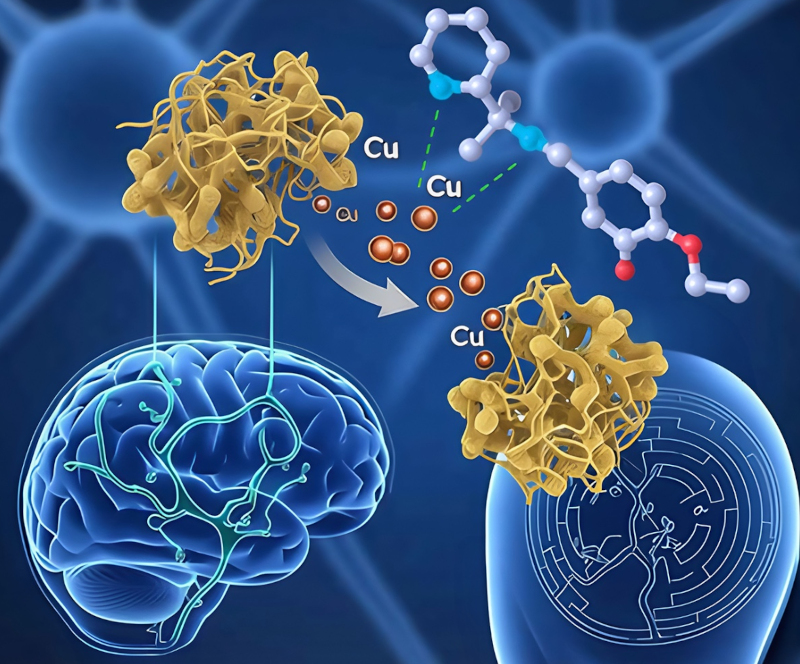

“The compound we’ve developed is much less expensive than available drugs. Therefore, even if it only works for part of the population, since Alzheimer’s disease has multiple causes, it’d represent a huge advance over current options,” says Giselle Cerchiaro, the study’s coordinator (image: ACS Chemical Neuroscience)
A group from the Federal University of the ABC tested the substance on rats and obtained positive results. The group is now seeking partnerships with pharmaceutical companies to conduct clinical trials.
A group from the Federal University of the ABC tested the substance on rats and obtained positive results. The group is now seeking partnerships with pharmaceutical companies to conduct clinical trials.

“The compound we’ve developed is much less expensive than available drugs. Therefore, even if it only works for part of the population, since Alzheimer’s disease has multiple causes, it’d represent a huge advance over current options,” says Giselle Cerchiaro, the study’s coordinator (image: ACS Chemical Neuroscience)
By Maria Fernanda Ziegler | Agência FAPESP – A team of researchers at the Federal University of ABC (UFABC) in Brazil has developed a new chemical compound with the potential to treat Alzheimer’s disease. The research involved computer simulations (in silico), cell culture tests (in vitro), and animal experiments (in vivo) and yielded promising results. The group is now seeking partnerships with pharmaceutical companies to conduct clinical trials.
The new compounds, developed with support from FAPESP, are simple to synthesize and believed to act by degrading the beta-amyloid plaques that accumulate in the brains of people with Alzheimer’s disease. These plaques form from amyloid peptide fragments deposited between neurons, causing inflammation and disrupting neural communication.
According to the study published in the journal ACS Chemical Neuroscience, the compounds act as copper chelators, binding to the excess copper present in beta-amyloid plaques and promoting their degradation. This reduces the symptoms of the disease. In tests conducted on rats, the chemical compound minimized memory loss, spatial awareness difficulties, and learning difficulties, in addition to biochemically reversing the pattern of beta-amyloid plaques.
“About a decade ago, international studies began to point to the influence of copper ions as an aggregator of beta-amyloid plaques. It was discovered that genetic mutations and changes in enzymes that act in the transport of copper in cells could lead to the accumulation of the element in the brain, favoring the aggregation of these plaques. Thus, the regulation of copper homeostasis [balance] has become one of the focuses for the treatment of Alzheimer’s,” explains Giselle Cerchiaro, a professor at the Center for Natural and Human Sciences at UFABC who coordinated the study.
Based on this knowledge, the research group synthesized molecules that can cross the blood-brain barrier and remove copper from beta-amyloid plaques. Of the ten molecules developed in the study, three were selected for testing in rats with induced Alzheimer’s disease. One molecule stood out for its efficacy and safety.
The work was the subject of the doctoral thesis of FAPESP scholarship recipient Mariana L. M. Camargo, the master’s thesis of Giovana Bertazzo, and the undergraduate research project of Augusto Farias. A research group led by Kleber Thiago de Oliveira, a professor at the Federal University of São Carlos (UFSCar), helped with the research project by synthesizing one of the compounds studied.
In tests with rats, the compound reduced neuroinflammation and oxidative stress, as well as restored copper balance in the hippocampus, the region of the brain associated with memory. Animals treated with the substance also showed improved spatial orientation.
In addition to the behavioral results, the tests showed that the compound was non-toxic to hippocampal cell cultures or to the animals, the vital signs of which were monitored throughout the experiment. Computer simulations confirmed the compound’s ability to cross the blood-brain barrier and target the affected areas directly.
Alzheimer’s disease is a complex, multifactorial neurodegenerative condition for which there is still no cure or defined cause. Despite its high prevalence – an estimated 50 million people worldwide live with the disease – therapeutic options are limited and only offer symptom relief or consist of complex drugs, such as monoclonal antibodies.
The UFABC study has generated a patent application, and researchers are now seeking partnerships with companies to begin human clinical trials. “It’s an extremely simple, safe, and effective molecule. The compound we’ve developed is much less expensive than available drugs. Therefore, even if it only works for part of the population, since Alzheimer’s disease has multiple causes, it’d represent a huge advance over current options,” Cerchiaro celebrates.
The article “Novel Copper Chelators Enhance Spatial Memory and Biochemical Outcomes in Alzheimer’s Disease Model” can be read at pubs.acs.org/doi/10.1021/acschemneuro.5c00291.
Republish
The Agency FAPESP licenses news via Creative Commons (CC-BY-NC-ND) so that they can be republished free of charge and in a simple way by other digital or printed vehicles. Agência FAPESP must be credited as the source of the content being republished and the name of the reporter (if any) must be attributed. Using the HMTL button below allows compliance with these rules, detailed in Digital Republishing Policy FAPESP.





